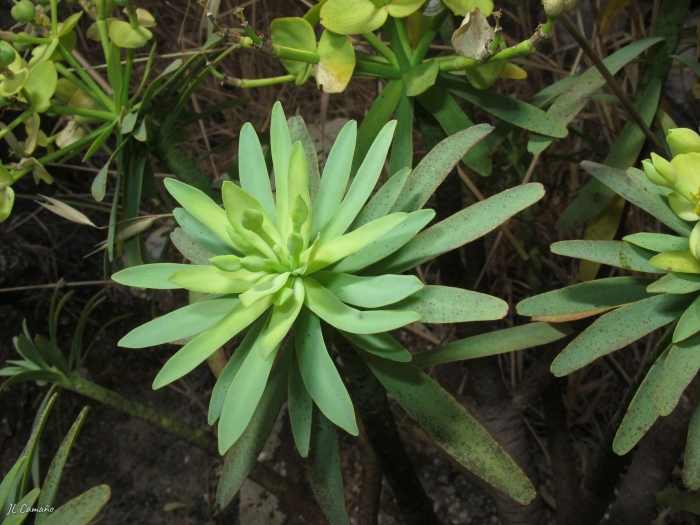Lamarck’s Spurge
(Euphorbia lamarckii)
Lamarck’s Spurge (Euphorbia lamarckii)
/
/

José Luis Camaño
CC BY-SA 4.0
Image By:
José Luis Camaño
Recorded By:
Copyright:
CC BY-SA 4.0
Copyright Notice:
Photo by: José Luis Camaño | License Type: CC BY-SA 4.0 | License URL: http://creativecommons.org/licenses/by-sa/4.0/ | Rights Holder: José Luis Camaño | Publisher: iNaturalist | Date Created: 2023-05-07T11:00Z |

























Estimated Native Range
Summary
Euphorbia lamarckii, commonly known as Lamarck’s Spurge, is a perennial shrub native to the rocky coastal areas, xeric shrublands, and semi-desert regions of the western Canary Islands, including Tenerife, north-western La Gomera, La Palma, and El Hierro. This species typically grows up to 7 feet tall and is characterized by its light brown, succulent stems and undivided, fleshy leaves that help conserve water. The small yellowish-green floral bracts are not particularly showy, but they are distinctive, with the inflorescence forming a compound umbel structure. The plant is also notable for its unique elaiosome—a fleshy structure attached to the seeds that is attractive to ants, which aid in seed dispersal.
Lamarck’s Spurge is adapted to the arid conditions of its native habitat and requires minimal water once established, making it suitable for xeriscaping and drought-tolerant gardens. It prefers well-draining soils and can tolerate a range of soil types, from sandy to loamy. Full sun is ideal for this plant, as it mimics the intense sunlight of its native environment. In cultivation, it can be used as an architectural plant due to its striking form and can serve as an interesting addition to rock gardens or succulent collections. However, gardeners should be cautious, as the sap of Euphorbia lamarckii is toxic and can cause skin irritation on contact.CC BY-SA 4.0
Lamarck’s Spurge is adapted to the arid conditions of its native habitat and requires minimal water once established, making it suitable for xeriscaping and drought-tolerant gardens. It prefers well-draining soils and can tolerate a range of soil types, from sandy to loamy. Full sun is ideal for this plant, as it mimics the intense sunlight of its native environment. In cultivation, it can be used as an architectural plant due to its striking form and can serve as an interesting addition to rock gardens or succulent collections. However, gardeners should be cautious, as the sap of Euphorbia lamarckii is toxic and can cause skin irritation on contact.CC BY-SA 4.0
Plant Description
- Plant Type: Shrub
- Height: 3-6 feet
- Width: 3-6 feet
- Growth Rate: Moderate
- Flower Color: Green, Yellow
- Flowering Season: Summer
- Leaf Retention: Evergreen
Growth Requirements
- Sun: Full Sun
- Water: Low, Medium
- Drainage: Medium
Common Uses
Border Plant, Deer Resistant, Drought Tolerant, Low Maintenance
Natural Habitat
Rocky coastal areas, xeric shrublands, and semi-desert regions of the western Canary Islands
Other Names
Common Names: Wood Spurge
Scientific Names: , Euphorbia lamarckii, Euphorbia broussonetii, Euphorbia broussonetii, Euphorbia lamarckii var. broussonetii, Euphorbia obtusifolia, Euphorbia obtusifolia var. wildpretii, Euphorbia virgata, Tirucalia virgata, Tithymalus obtusifolius
GBIF Accepted Name: